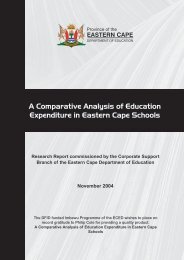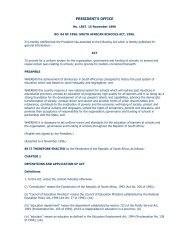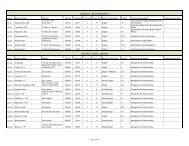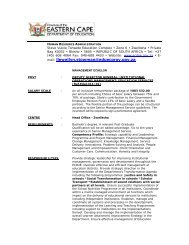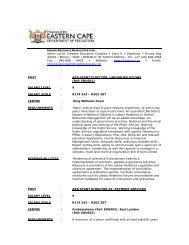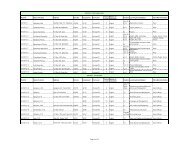part a: strategic overview - Department of Education
part a: strategic overview - Department of Education
part a: strategic overview - Department of Education
Create successful ePaper yourself
Turn your PDF publications into a flip-book with our unique Google optimized e-Paper software.
12. INTRODUCTION<br />
PART C: BACKGROUND INFORMATION<br />
While Section 3 <strong>of</strong> the plan presents details on each sub-programme and highlights where<br />
<strong>strategic</strong> objectives are placed both budget-wise and organizationally, Part C <strong>of</strong> the Strategic<br />
Plan document is intended to provide the essential details about the background information<br />
upon which the plan is based. The purpose <strong>of</strong> this section <strong>of</strong> the document is to further<br />
contextualize the goals and objectives <strong>of</strong> the plan, to highlight the circumstances and issues<br />
from which planned priorities were derived, and to present the essential boundaries <strong>of</strong> activity<br />
within which the De<strong>part</strong>ment will operate in implementing the plan. This section <strong>of</strong> the plan is<br />
important both as a backdrop which gives meaning to the activities to be undertaken and as a<br />
guide which seeks to inform <strong>of</strong>ficials and stakeholders about the best way to manoeuvre<br />
among the activities and complexities which will define scope and context <strong>of</strong> delivery.<br />
This section <strong>of</strong> the plan is therefore divided into two main sections and several sub-sections.<br />
The sections and sub-sections are outlined below.<br />
13. ANALYSIS OF THE SERVICE DELIVERY ENVIRONMENT<br />
o Policy Changes and Trends<br />
o Environmental factors and emerging challenges<br />
o Demographic Pr<strong>of</strong>ile <strong>of</strong> the Eastern Cape<br />
o Social Economic Deprivation in Eastern Cape Communities<br />
o Analysis <strong>of</strong> the <strong>Education</strong>al System<br />
o Demographic pressures and access issues<br />
o <strong>Education</strong>al pr<strong>of</strong>iles <strong>of</strong> people<br />
o Transfers to Institutions<br />
o The state <strong>of</strong> Public Ordinary Schools education<br />
o Independent Schools<br />
o LSEN Schools<br />
o FET<br />
o ABET<br />
13.1 Policy Changes and Trends<br />
With the increased use <strong>of</strong> computer technology in more and more aspects <strong>of</strong> life, government<br />
recognized the need to pass legislation that would provide the framework for regulating<br />
electronic communications, such as email, and establish the legality <strong>of</strong> electronic business<br />
transactions. The Electronic Communications and Transactions Act (Act 25 <strong>of</strong> 2002)<br />
(ECT) provides for the facilitation and regulation <strong>of</strong> electronic communications and<br />
transactions; the development <strong>of</strong> a national e-strategy; universal access to electronic<br />
communications and transactions; human resource development in electronic transactions;<br />
the prevention <strong>of</strong> abuse <strong>of</strong> information systems; and to encourage the use <strong>of</strong> e-government<br />
services.<br />
This is an important act for educational institutions seen against the requirement to provide<br />
access to and training in the use <strong>of</strong> computers and to enable people to make the transition<br />
into the world <strong>of</strong> the Internet and other computer-based work methods.<br />
The e-<strong>Education</strong> Draft White Paper <strong>of</strong> the National De<strong>part</strong>ment <strong>of</strong> <strong>Education</strong> was published<br />
in August 2003. It has the overall policy goal that ‘Every South African learner in the general<br />
and further education and training bands will be “ICT capable” that is, use Information and<br />
Communications Technology (ICT) confidently and creatively by 2013.<br />
The relevant policy imperatives are set out under six <strong>strategic</strong> objectives:<br />
5 Year ECDoE Strategic Plan for 2005/06 2005-06 to 2009/10 2009-10. March 21 F (3) 2006 Page 53<br />
Page 49




